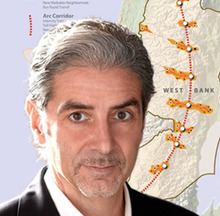Full Name Doug Suisman Occupation Architect Practice Suisman Urban Design | Nationality USA Website suisman.com | |
 | ||
Books Los Angeles Boulevard: Eight X-rays of the Body Public, The Arc: A Formal Structure for a Palestinian State | ||
Doug Suisman (born 14 March 1955) is an award-winning American urban designer and architect.
Contents
Suisman founded the Los Angeles-based firm, Suisman Urban Design, in 1990 and has since worked on projects in a variety of cities including Los Angeles, Ramallah, and Vancouver, among others. His work emphasizes sustainable development, public transportation, communal spaces and structures, and walkable streets. His projects include master plans and facilities for regional transit systems, downtowns, cultural districts, university campuses, transit-oriented development, civic and community centers, plazas, parks, and streetscapes.
Suisman won the Top Master Plan and Future Project of the Year award at the 2010 World Architecture Festival for The Arc. Suisman's iQuilt cultural district plan for downtown Hartford, won an AIA Honor Award and two grants from the National Endowment for the Arts. In 1999, Suisman was made a Fellow of the American Institute of Architects. In 2006, Suisman was named a National Peer in Urban Design by the U.S. General Services Administration.
Suisman is the author of Los Angeles Boulevard, described by Christopher Hawthorne, Los Angeles Times Architecture Critic, as, "...the most important take on this gigantic subject."
Early life and education
Suisman was born and raised in Hartford, Connecticut. He attended Phillips Academy in Andover, Massachusetts from 1968 to 1972 and earned his Bachelor of Arts from Yale University in 1976, graduating Cum Laude. In 1981, Suisman obtained his Master of Architecture from Columbia University and was awarded an American Institute of Architects Medal.
Academia
Influenced by Reyner Banham's Los Angeles: The Architecture of Four Ecologies, Suisman moved to Los Angeles in 1983. From 1984 to 1988, he taught architectural design courses at the University of Southern California while studying the urban layout of Los Angeles and collecting research for his 1989 book, Los Angeles Boulevard. In 1987, Suisman won a grant from the National Endowment for the Arts for his study of the "relationship between architecture and movement in American cities." From 1989 to 1991, Suisman taught architectural design and theory at the University of California, Berkeley.
Projects
In 1997, Suisman collaborated with Meléndrez Associates, Johnson Fain, RAW International, and Landmark Partners to create a master plan for the Civic Center of Los Angeles. Dubbed the "Ten Minute Diamond," the plan envisioned a diamond-shaped district based on a ten-minute walk from the central rotunda of City Hall. The diamond was divided into four quarters: Riverbed, New Town, Hillside, and Old Pueblo, with City Hall as the central feature. The project drew attention from a variety of media outlets including the Los Angeles Times.
In 2001, the Los Angeles County Metropolitan Transportation Authority unveiled Suisman's redesign of the Metro Rapid graphics and architecture. Suisman's improvements included new branding for the buses and stations, and bus stops that featured skylit canopies and electronic signs with real-time arrival information.
Suisman's collaboration with the RAND Corporation led to "The Arc: A Formal Structure for the Palestinian State," a master plan that envisioned a transportation and infrastructure corridor that would link the West Bank and Gaza Strip. Suisman received international attention for his plan, Bloomberg News described it:
A concept of breathtaking sweep and simplicity, yet surprisingly practical...the elegance of Suisman's idea ad its ready comprehensibility has drawn worldwide political press and political attention.
In 2008, The Children's Museum of Pittsburgh hosted the "Charm Bracelet Competition," a design competition that selected four teams out of a pool of both national and international entrants, and chose Suisman as one of the four teams to reinvigorate the North Side neighborhood of Pittsburgh, formerly known as Allegheny City. Working with the Urban Lab at Carnegie Mellon University, Suisman intensively researched the history of the North Side neighborhood and devised a plan to revitalize the area.
That same year, Suisman began developing the iQuilt Plan for Downtown Hartford, a master plan that imagined a more culturally and spatially connected Hartford, Connecticut. In 2010, his design won another AIA Honor Award.
Personal life
Suisman resides in Santa Monica, California with his wife and two children.
